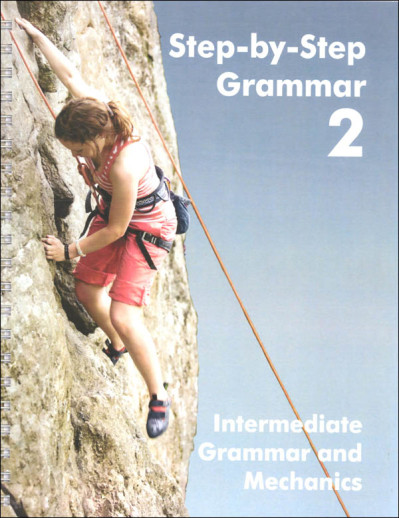We use cookies to make your experience better. To comply with the new e-Privacy directive, we need to ask for your consent to set the cookies. Learn more.
Step-by-Step Grammar 2: Intermediate Grammar and Mechanics
Students will learn the rules for written English and practice putting sentences together properly and punctuating them correctly. Students will also review the basic eight parts of speech and learn about gerunds, participles and infinitives.
Step-by-Step Grammar 2: Intermediate Grammar and Mechanics was written to be used after Step-by-Step Grammar I: Basic Grammar.
Some topics covered are:
- periods
- commas
- semicolons
- colons
- apostrophes
- quotation marks
- question and exclamation marks
- singular and plural
- subject-verb agreement
- pronoun-antecedent agreement
- homographs
- pronoun usage
- gerunds
- participles
- infinitives
- nominative vs. objective case pronouns
The authors of these books believe that students should not have to deal with parts of speech he/she has not yet learned, so this book is organized in a different way than most grammar books. The first book introduces grammar concepts step-by-step, and the corresponding exercises contain only words which have already been explained. For example, the first page introduces nouns and action verbs right at the beginning, and then students work with two word sentences containing only nouns (subjects) and action verbs. Students label the parts of speech and write their own action verbs or nouns to go with the provided lists of nouns and verbs. More information about nouns is given, and students work through a couple more short exercises. Then they learn how to diagram these sentences (still working with just a subject and verb). The next page introduces linking verbs as well as another noun form (predicates), and then children complete another short exercise, now working with three-word sentences. Then they learn how to diagram these latest sentences before moving on to adjectives. Hence, Step-by-Step Grammar! This method prevents children from being overwhelmed by sentences which they do not understand when they begin learning grammar. Each part of speech is introduced systematically, and different types or functions of different parts of speech are introduced separately so children don't get an overload of rules at one time. Rather, one concept is introduced with a brief explanation followed by a clear example. The exercises between new concepts are long enough to give students some practice yet short enough that they aren't doing unnecessary work. Because students practice sentence diagramming after each new concept has been added, they are never faced with a sentence they don't already know how to diagram. Spiral bound, 119 pages.
If you need help studying for your Basic Grammar test, the Study Cards will help your child memorize important grammar facts. This useful set of sixty-three 2 ¾" x 4 ¼" cards contains the study prompts such as, "types of verbs," "definition of an adjective," and "list the eight parts of speech" one one side, with the other side featuring the correct answer and the location in the text to look them up if you need to review.
The second book builds on the concepts covered in the first book, covering slightly more advanced topics such as word usage, dictionary skills, sentence structure, punctuation rules, writing tips, and other concepts. Students should complete this book after the first book or something comparable. The format of this book follows the same basic manner as the first. Spiral bound, 164 pages.
Everything about these books is simple and straightforward, and the layout is very neat and clean. Periodic review quizzes help you evaluate your child's progress and determine if they are ready to move on or if they need more practice. The back of each book holds a convenient handbook where children can easily look up definitions and explanations of the concepts. The answer keys depict the exercises as they look in the book with the answers filled in, and they are also spiral bound. - Melissa


This has made sense to my kids, aged 11, 13, and 16
These books are simple and straight forward. Great for review, covering topics they might have missed and for children struggling with grammar. Originally I purchased these books for our older…
for my 5th grader homeschool
This grammar book has wonderful teaching boxes followed by exercises to practice skills. It has cumulative review built in, and the handbook in the back is a wonderful resource for students. Do…